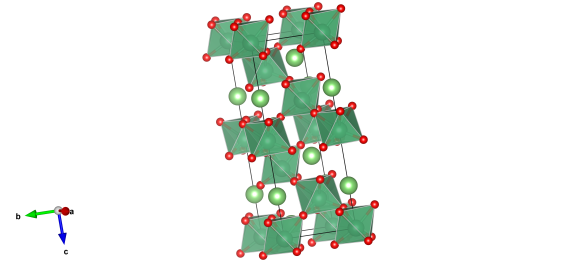Crystals of temperature and electricity – Pyroelectric lithium niobate
In the last couple of weeks we've had a couple of posts about piezoelectric materials (see posts on PZT and Triglycine sulphate). Today we'll introduce another property of materials, pyrolectricity!
What does it look like?

The crystal structure of lithium niobate. The light green atoms are lithium, dark green niobium which bond with the red oxygen atoms. Image generated by the VESTA (Visualisation for Electronic and STructural Analysis) software http://jp-minerals.org/vesta/en/
What is it?
This is the crystal structure of lithium niobate, which is a pyroelectric structure (as well as being a ferroelectric). Where piezoelectric crystals (like quartz, PZT and Triglycine sulphate) can generate charge when the crystal is pressurized, in pyroelectrics charge is generated when the temperature of the crystal is changed.
This is a feature of materials that crystallise in polar space groups, which is a set of crystallographic space groups that do not have a fixed origin to their symmetry. Therefore to represent these materials the origin is usually fixed on an atom – in the case of lithium niobate, the investigators have fixed the origin to the niobium atom.
Pyroelectric materials can be used to drive nuclear fusion, and have been the driving force for developing 'bench-top' fusion. This was shown by Naranjo et al. in 2005, who used a similar material (lithium tantalate; the same structure as we've shown above, only the niobium atoms are replaced by tantalum). They used charge, created by heating a lithium tantalate crystal, to ionize and accelerate deuterium atoms into a target. This fused some of the deuterium atoms, creating a helium-3 atom and a neutron.
Where did the structure come from?
The structure of lithium niobate was taken from a paper by Abrahams et al. from 1966 (it hasn't made it to a database yet).






